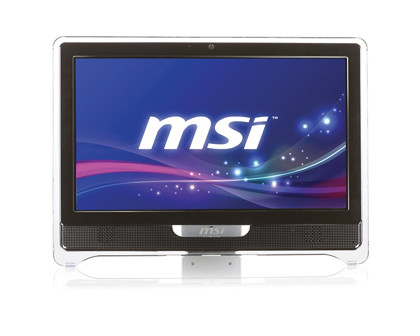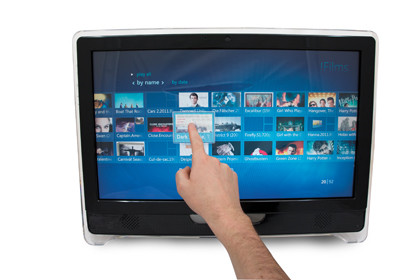
Ubiquitous access to touch-enabled devices is going to mean every Windows game developer on planet earth will be looking to integrate touch features into their latest release.
So we can take a look at how touch-enabled systems will run Windows 8, enhance your gaming experience and generally make the world a better place.
There's simply no arguing that Microsoft – publisher of the single most important OS on the planet – has been utterly routed by the more nimble Apple and Google.
It may have released touch-enabled systems years ago with Windows Mobile and Windows Tablet Edition, but in its usual blinkered this-is- to-sell-more-Windows way managed to kill the market dead for these and many other innovative products. Anyone remember Microsoft Smart Display? Or project Courier?
This time around touch will be different. Microsoft doesn't have to innovate, phew, as Apple and Android has done all of that for it. We can just sit back, relax and wait for the touch-enabled, app-store-integrated, widget-brandishing, button-sliding progeny of Windows to make its appearance.
The odd thing is, it's really rather exciting. For the first time we're going to have the chance at a genuine ecosystem of Windows devices to choose from: moving from Windows phones, to Windows tablets up to netbooks and laptops and then desktop systems. All touch-enabled, all interconnected via Windows Live and all offering the same touch games and applications.
Next generation hardware is already appearing so let's take a look at how touch-devices work with Windows 8, existing and future games.
Get daily insight, inspiration and deals in your inbox
Sign up for breaking news, reviews, opinion, top tech deals, and more.

The gloss-black MSI all-in-one flares into life. The remnants of an ancient BIOS briefly shows itself – still infecting even this most modern of machines – before a Metro-style pale-blue OS boot menu presents itself. Its uber-modern fine sans-serif type couldn't be more removed from the chunky fixed-type on BIOS screens of old.
Tap the extra options and you see a selection of recovery and boot features, before going back and tapping the frame-less Windows 8 button to start it. Within seconds a widescreen HD mountain vista is displayed, the date and time boldly displayed in that stylish new Segoe typeface.
A swipe up reveals the Windows user accounts, ideally tied to Windows Live accounts they will take your preferences, avatar images, email, documents and apps with you to any device you use. Tapping one brings up the visual lock-screen – a personalised picture that requires you to motion over areas you've previously selected to gain full user access.
Security passed, the new Windows 8 Start Menu springs forth; this living breathing menu emanates life, as individual app cards update and refresh themselves. Feeds show real-time posts and games show online players stats.
The expansive, horizon-style Start Menu can be effortlessly scrolled through, with a tap here you can check your tweets, a tap there you can scroll through your latest news streams.
Media Center makes it a simple job to flick through menus of media and choose the music, photos and films you want to view. Tap the latest Windows Store, grab a game and enjoy gaming in a new way.
Hands on with Windows 8

The release of Windows 8 will simply solidify this touch journey but for now models, such as the MSI Wind Top AE2210 or the Dell Inspiron 2320 – both all-in-one models – elegantly show the touch-enabled future that awaits as they can have the Windows 8 Developer Preview installed on them.
We know the Developer Preview was really a beta version but even so, the semantics of a number of gestures were a little unnecessarily obscured. Using it you get a better idea that the demo at last year's Microsoft Build conference while live had been well practised and orchestrated.
We regularly ran into issues trying to switch between apps and the dock system seemed limited and frustrating to use. But it's hard to complain about something that hasn't even been released in an official form. Even guessing, there's no chance of a Windows 8 release until summer 2012. Microsoft has a lot to sort out before then beyond just getting a swanky touch-interface working correctly.
The Windows Store is probably the easiest, cross-device migration of settings and is another easy thing to sort via Windows Live accounts.
But it's the often overlooked elements of life where pleasure can really be taken, like reading on the toilet or removing an annoying bogey from your nose. Our old-friend Windows Media Centre is an excellent touch-enabled bit of software.
Whether that's through luck or flaw we can't say, but flicking through films, music and photos is a lovely experience. One we're sure could be made even better if a little style and thought was put into it.
The Media Center photo screensaver is still one of the worst experiences we've had besides hiding under our bed covers as children listening to our parents fight.
Windows playtime

Where our real interest lies is with gaming. Touch on mobile devices has ushered in a new way to game. While we're not expecting the same paradigm shift on the desktop, access to casual mobile games will always be a good thing, but we do expect touch elements to start drip feeding into triple-A titles.
The splendid thing is we can already try some of these features out on existing titles, that have been either knowingly or unwittingly enabled for touch gaming. The richest area of gaming for touch-aware titles is the hated casual game, you can stop making hissing noises. Some people – we imagine a few of those that have racked up over half a billion downloads of Angry Birds – actually do like what we deridingly call 'casual' games.

With many Flash-based browser games designed for easy mouse input, or more likely for touch-aware input, these are all able to work flawlessly with a touch PC. We've already mentioned the most obvious casual game: Angry Birds. This has a free PC version online at chrome.angrybirds.com that works on any HTML5-aware browser and plays beautifully on touch-screen equipped PCs and on a much larger scale than any tablet or phone could hope to manage on its own.
We did run into a few odd instances with Internet Explorer, it has its own touch-controls built in and a wrongly-placed finger can have you browsing off to other locations. Equally well-equipped are the flash-based games to be found over at www.popcap.com the likes of Bejeweled and Plants Vs Zombies, these Flash games again work perfectly on a touch-enabled PC.
It's also worth pointing out the browser add-in Swiffout.com that enables you to run embedded Flash games full screen. It's a bit hit and miss, as in it'll sometimes seem like the game isn't doing anything.
If you think there's a big selection of casual games available online now, just you wait until Windows 8 hits the streets. We'd expect most Windows Phones games to be quickly ported, that's if they're not natively supported from day one, while dedicated Windows 8 Tablet games are going to quickly appear.
If casual gaming is your thing, if nothing else children gobble them up like space-dusted cake, then expect a flood to come in from Android and iOS devices.